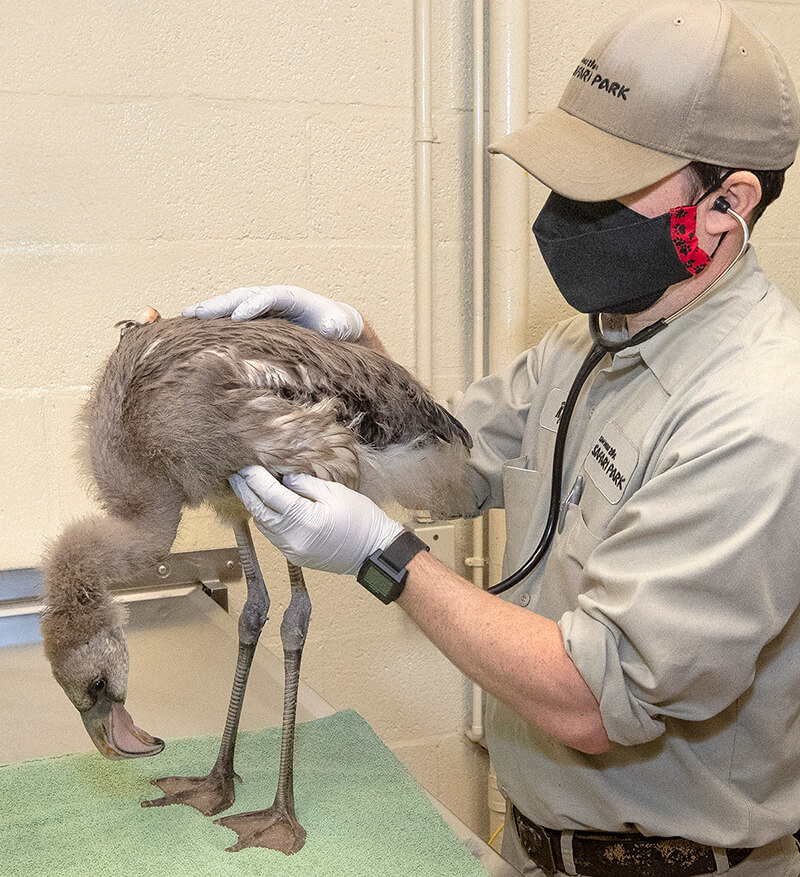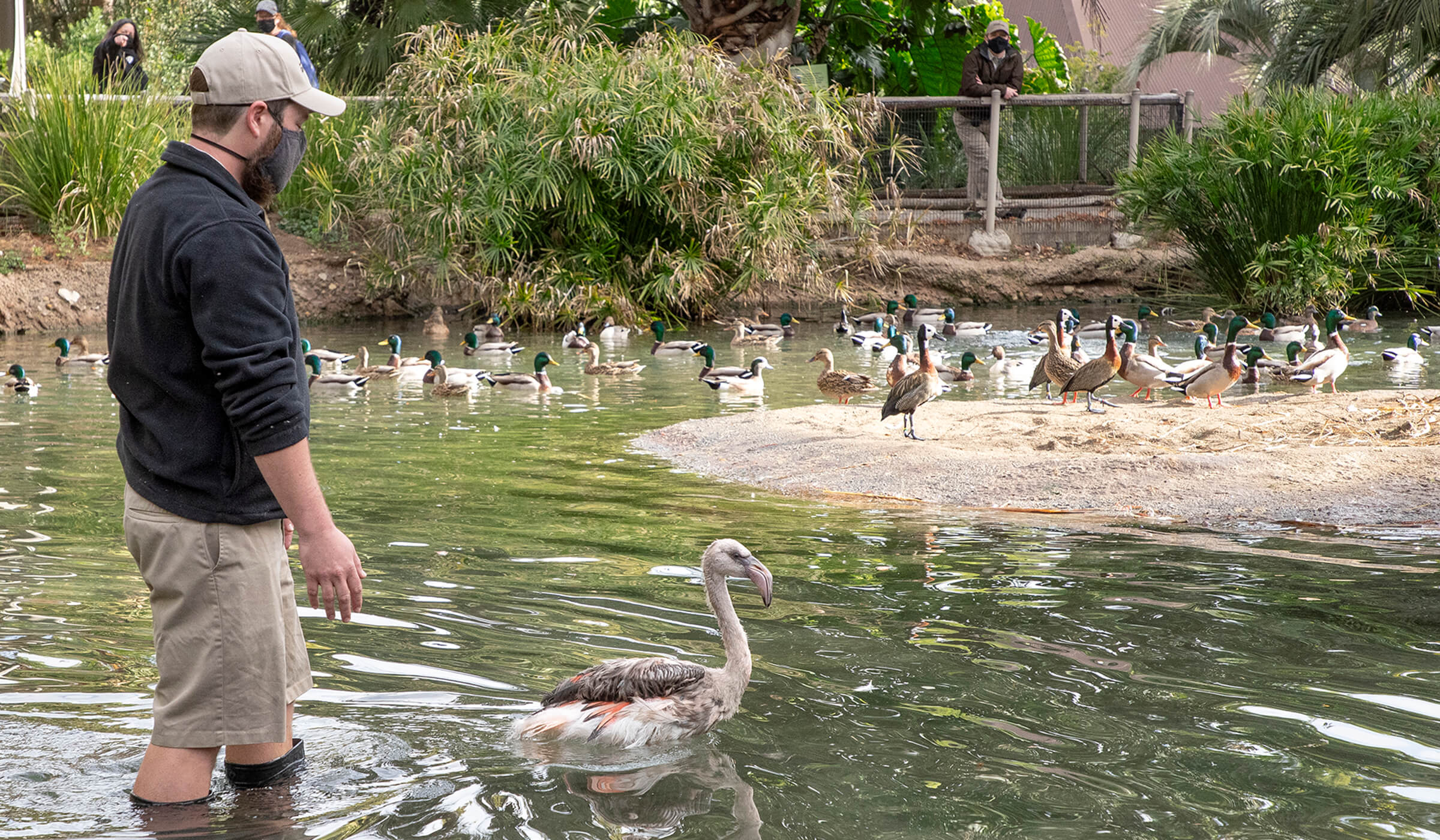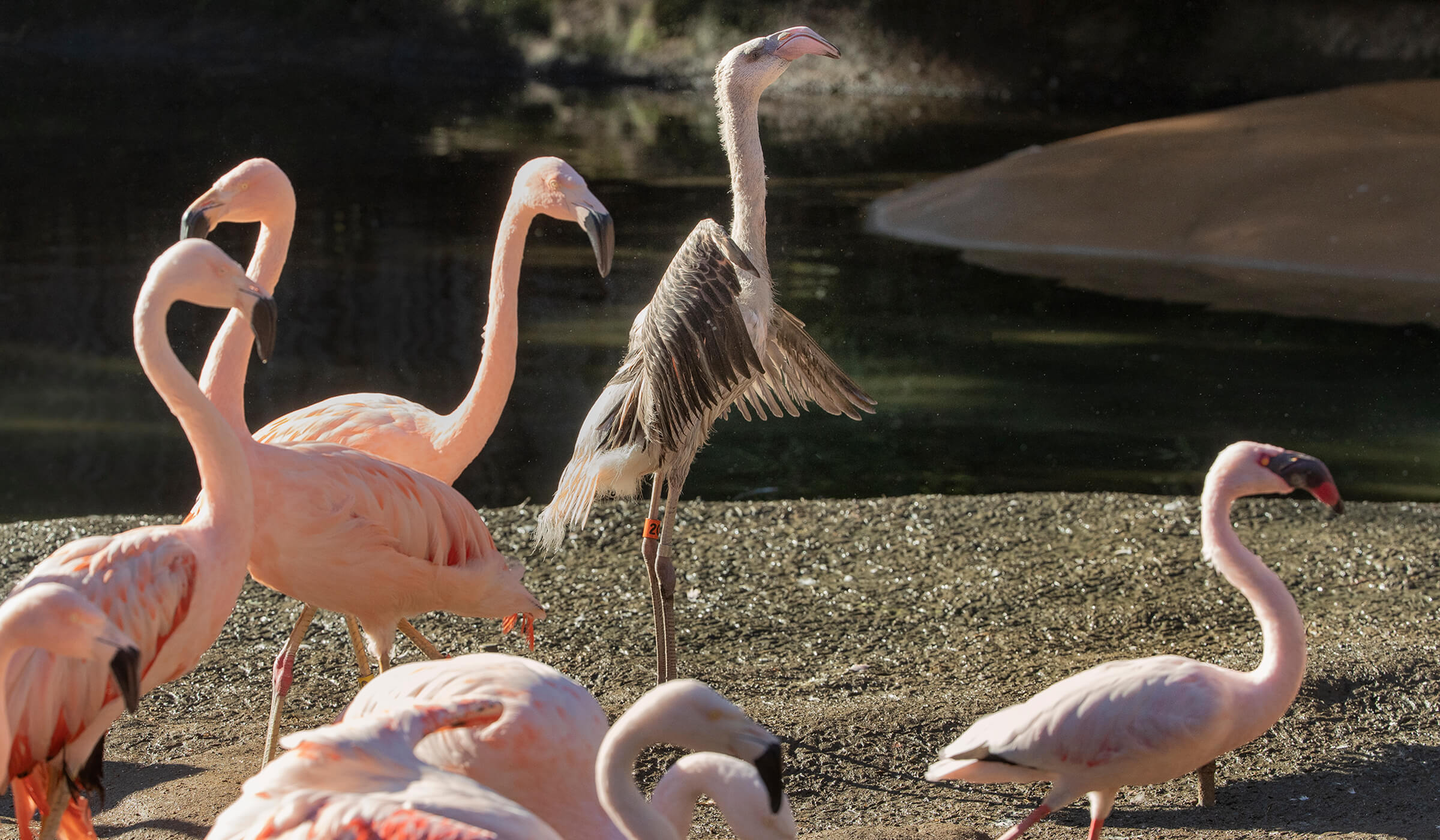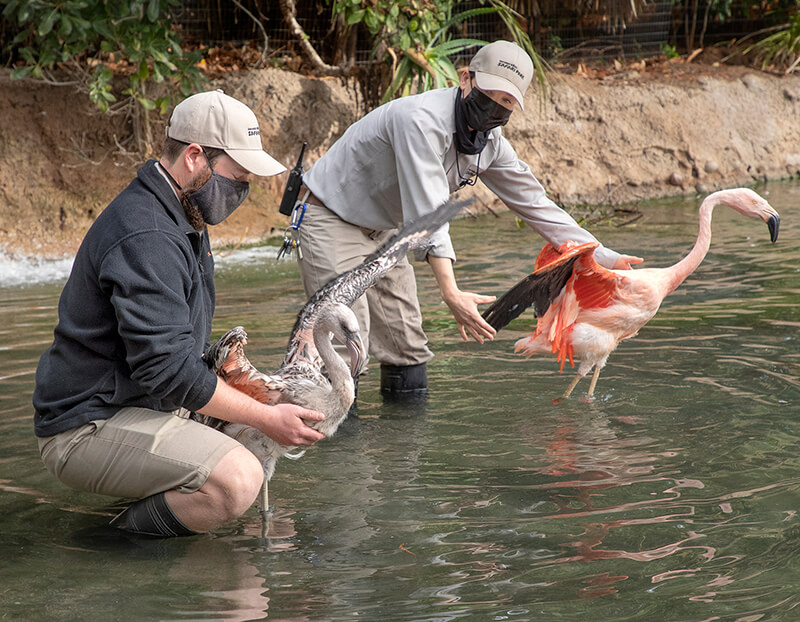Image

Whether they’re youngsters or adults, flamingos spend a lot of time in or near the water. Flamingo chicks hatch from eggs laid in mud nest mounds built near the water. And they eventually grow up to spend much of their lives with at least one foot in the water, looking for food. As they stand in a pond or a lake, they filter water through their beaks to catch and eat tiny crustaceans. However, just because they spend so much time in or around water doesn’t mean that water can’t pose dangers to flamingo chicks.
Last October, wildlife care specialists noticed that a month-old chick in the Safari Park’s Chilean flamingo flock was in distress, and was having trouble breathing. “The chick had fallen into the water,” explained Dr. Ryan Sadler, a veterinary clinical fellow at the Safari Park’s Paul Harter Veterinary Medical Center. “The fall wasn’t witnessed, but wildlife care specialists noticed that the chick was having trouble breathing.”
[caption id="attachment_138719" align="aligncenter" width="800"] HELPING HANDS
HELPING HANDS
Veterinary staff examined a month-old Chilean flamingo chick that Safari Park wildlife care specialists had spotted in respiratory distress, and provided successful treatment for a case of fungal pneumonia.[/caption] Getting wet usually isn’t a problem for flamingos—as long as the water stays on the outside of their bodies. However, if water from the flamingo pond gets inside the lungs of a chick, organisms in the pond water can cause serious health issues. The flamingo chick was rescued and taken to Harter Veterinary Medical Center for care. “The fear was that the chick could develop an infection,” Dr. Sadler said. As it turned out, the chick exhibited signs of pneumonia, respiratory illness, and infection. The wildlife care team started nebulization to quickly administer medication directly to the chick’s lungs via a fine mist, for rapid absorption. Veterinary staff also discovered a large lesion on the left side of the chick’s brain. Lesions can be caused by an injury, illness, or infection, and are often treated by antibiotics. The chick received intensive care at the hospital, but veterinarians and staff providing treatment were careful not to allow the chick to become attached to its caregivers. “We didn’t want it to get too used to people,” Dr. Sadler explained. The goal was to get it healthy, then get it back to its own flock. [caption id="attachment_138720" align="aligncenter" width="2400"] WADING IN
WADING IN
While Chilean flamingos spend most of their lives in or near the water, tiny organisms that live in pond water can cause health issues for chicks if that water gets in their lungs.[/caption] REJOINING THE FLOCK
REJOINING THE FLOCK
Following its recovery at Harter Veterinary Medical Center, the healthy chick returned to its Chilean flamingo flock.[/caption] BACK HOME AGAIN
BACK HOME AGAIN
Once the flamingo chick was “in the pink” again, wildlife care specialists reintroduced the youngster to its habitat at the Safari Park.[/caption] Through late December and early January, several other flamingos were being kept at the hospital for treatment of foot issues. The timing was ideal, giving the recovering flamingo chick a substitute flock to socialize with, Dr. Sadler said. “The growing chick was learning from them how to be a flamingo.” On January 21, the flamingo chick was examined again, and there was good news: the chick was found to have only a few residual lesions. “We suspect they’re scar tissue,” Dr. Sadler said. A tentative plan was made to return the chick to its flock at the Safari Park on the first week of February. The release from the hospital and return to the habitat went as planned, and the chick rejoined the more than 80 birds in the Safari Park’s Chilean flamingo flock. “It took a lot of effort, but—fingers crossed—we’re hopeful this young flamingo will grow up strong and healthy.”
 HELPING HANDS
HELPING HANDSVeterinary staff examined a month-old Chilean flamingo chick that Safari Park wildlife care specialists had spotted in respiratory distress, and provided successful treatment for a case of fungal pneumonia.[/caption] Getting wet usually isn’t a problem for flamingos—as long as the water stays on the outside of their bodies. However, if water from the flamingo pond gets inside the lungs of a chick, organisms in the pond water can cause serious health issues. The flamingo chick was rescued and taken to Harter Veterinary Medical Center for care. “The fear was that the chick could develop an infection,” Dr. Sadler said. As it turned out, the chick exhibited signs of pneumonia, respiratory illness, and infection. The wildlife care team started nebulization to quickly administer medication directly to the chick’s lungs via a fine mist, for rapid absorption. Veterinary staff also discovered a large lesion on the left side of the chick’s brain. Lesions can be caused by an injury, illness, or infection, and are often treated by antibiotics. The chick received intensive care at the hospital, but veterinarians and staff providing treatment were careful not to allow the chick to become attached to its caregivers. “We didn’t want it to get too used to people,” Dr. Sadler explained. The goal was to get it healthy, then get it back to its own flock. [caption id="attachment_138720" align="aligncenter" width="2400"]
 WADING IN
WADING INWhile Chilean flamingos spend most of their lives in or near the water, tiny organisms that live in pond water can cause health issues for chicks if that water gets in their lungs.[/caption]
Growing Up in a Flamingo Flock
This Chilean flamingo hatched on September 22, 2020, at the end of the adult flamingos’ May through September breeding season. At the Safari Park, as in their native habitats, adult flamingo pairs build cone-shaped mud nests to hold a single egg, and they guard their mound carefully to keep other birds from stealing their prime nesting location. Once an egg is laid, both parents typically take turns incubating it, for 27 to 31 days. After the egg hatches, the new chick stays in the nest for an average of three to five days, occasionally peeking out from under its brooding parent’s wing. Both parents feed their chick by producing “crop milk,” a substance created in the parents’ esophagus. After just five days in the nest, a flamingo chick may begin to walk around, may start swimming, and might decide to leave its island nest permanently, to explore its habitat. It will join a group of other chicks called a crèche, which is cared for by an adult flamingo—sort of a bird version of daycare. But the chick will still call its own parents when it’s time to be fed crop milk, and each parent will respond to its own chick’s unique call. In the first two weeks of a Chilean flamingo’s life, its bill is straight instead of having the downward turn of an adult’s bill. When the bill develops its adult shape, the chick will have the capability to filter feed—straining food out of a bill full of water, often producing a unique buzzing sound that is something like a boat motor. When chicks are about a month old, their soft, gray down begins to give way to a few feathers. Flamingo chicks grow quickly, reaching a standing height of about two feet at 30 days of age. By the time a chick is three months old, it may have already reached its full adult size, although it is still lacking its adult coloration. [caption id="attachment_138721" align="aligncenter" width="2400"] REJOINING THE FLOCK
REJOINING THE FLOCKFollowing its recovery at Harter Veterinary Medical Center, the healthy chick returned to its Chilean flamingo flock.[/caption]
The Right Time for a Rescue
Fortunately, the 26-day-old Chilean flamingo chick rescued at the Safari Park had already reached the stage where its parents had stopped providing constant care and feeding, and the chick was able to feed itself. “We didn’t have to simulate feeding by its parents, because the chick was already eating on its own,” Dr. Sadler said. By November 3, the chick’s infection was gone. “However, if the medication that treats fungus is discontinued too soon, the fungus will come back,” Dr. Sadler said. “We needed to design a special therapy and treatment plan to continue on for the long term.” A major part of the recovery plan for the flamingo chick was preparing it for an eventual return to its flock. “Flamingos are very delicate birds,” Dr. Sadler said. “This chick spent a long time in the hospital, away from its flock. So, we worked with bird care specialists and the hospital team to create as naturalistic a habitat at the hospital as possible, and maintained the chick with other birds.” [caption id="attachment_138722" align="aligncenter" width="800"] BACK HOME AGAIN
BACK HOME AGAINOnce the flamingo chick was “in the pink” again, wildlife care specialists reintroduced the youngster to its habitat at the Safari Park.[/caption] Through late December and early January, several other flamingos were being kept at the hospital for treatment of foot issues. The timing was ideal, giving the recovering flamingo chick a substitute flock to socialize with, Dr. Sadler said. “The growing chick was learning from them how to be a flamingo.” On January 21, the flamingo chick was examined again, and there was good news: the chick was found to have only a few residual lesions. “We suspect they’re scar tissue,” Dr. Sadler said. A tentative plan was made to return the chick to its flock at the Safari Park on the first week of February. The release from the hospital and return to the habitat went as planned, and the chick rejoined the more than 80 birds in the Safari Park’s Chilean flamingo flock. “It took a lot of effort, but—fingers crossed—we’re hopeful this young flamingo will grow up strong and healthy.”




